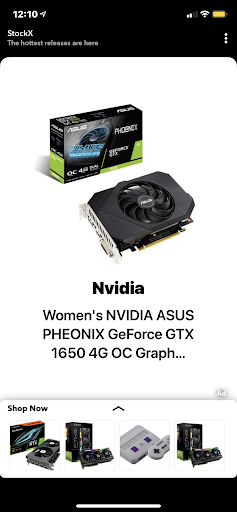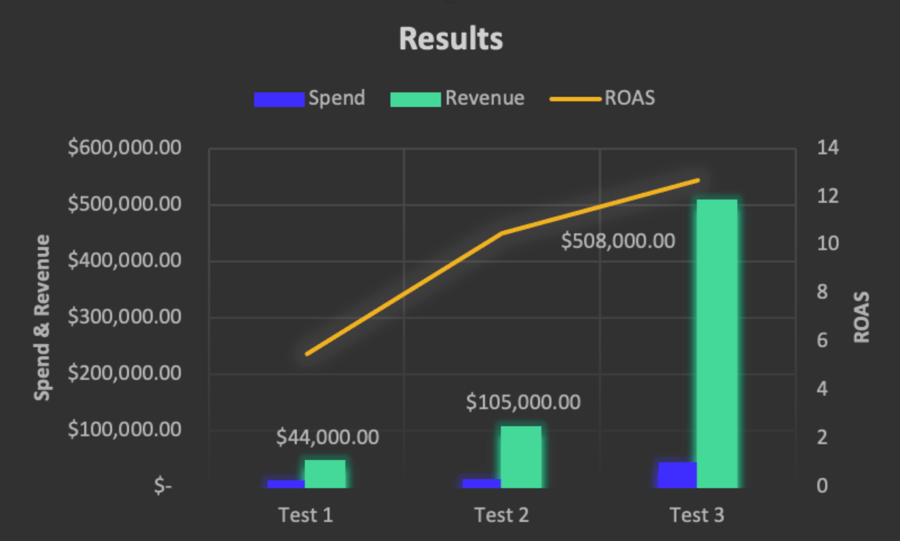Not optimizing your feed is like letting Santa give your presents away to the neighbors. On Christmas Eve, my dad and older brothers would climb onto the roof and clip-clop around for a bit, jingling bells while I was already tucked into bed. As everyone knows, you really don’t sleep the night before Christmas… so naturally, I was wide awake.
I can remember hearing the commotion, giddy with excitement, but I didn’t dare leave my room. I couldn’t risk Santa seeing me. My dad said that if Santa saw me out of bed, it would ruin the surprise and he would put me on the naughty list — and give my presents to the neighbors!
Don’t judge, I was like, seven.
Let me explain…
Problem 1: Wasting ad spend on unoptimized catalogs
“I thought all I had to do was install the Snapchat app on my Shopify store and that everything would be perfectly optimized, right?” That’s what your competitors want you to think! But, no.
Here’s an example of a bad Snapchat catalog ad (aka a one-way ticket to the naughty list):

Apparently, I’m not much of a computer geek, because I had no idea what the product even was.
But here's how I could tell the ad owner's feed wasn't optimized:
- Nondescript product photo on a white background? Check.
- Product title that appears as if it came straight from the manufacturer on Alibaba? Check.
- Wasted space listing the brand name twice? Check.
- Causing confusion by specifying gender on a piece of tech? Check.
Let’s imagine that by some stroke of Christmas magic, someone saw this ad and genuinely wanted to buy it. Assuming they didn’t swipe up on that gem of creative perfection when it came up on their feed, they’d head to Google.
Unfortunately for the advertiser, there are 13 Shopping listings of this product from competitors, before the listing from the company that paid for the ad above.
They’ve just paid for their competitor to get a sale, which broke the #1 rule of listing ads on Snapchat: Don't pay for your competitors to steal your business.
Problem 2: Not being able to reach target ROAS
Prior to onboarding, our client tested Snapchat ads, but couldn’t hit overall ROAS goals — even running just retargeting.
Our client is a children’s boutique that has experienced massive success on Facebook and Google, but when running a few tests on Snap, they weren’t hitting their goal of 10x ROAS (Return on Ad Spend).
Back in 2019, they spent $8K at a 5.5x ROAS over a month and a half. The majority of this spend was on retargeting. We prefer to see a much higher ROAS on retargeting which allows for more spend on prospecting net new users. When they tested prospecting, they barely got above a 1x on $1K in spend. They were using graphic video ads showcasing a selection of outfits while targeting a lookalike audience. As far as they were concerned, Snap wasn’t going to work.
With a new strategy, Elumynt was able to hit efficiency goals, but our scale was limited.
Once Elumynt came on board we wanted to give Snapchat another shot. By refreshing the content and ad formats based on what we know works and modifying the bid strategy and ad setup on the exact same audience, we achieved a 10.5x ROAS on $10K in spend.

This was a big deal for our client, and worth celebrating. That said, while we were effectively bringing in new customers and incremental revenue on a channel they had previously written off, we knew there was still so much more on the table with Snapchat.
Problem #3: Scaling Catalog Sales ads efficiently
DPAs (Dynamic Product Ads) on many platforms are typically uber-efficient for apparel brands. Just like people love browsing through boutiques, they love swiping through a collection of outfits, shoes, or accessories.
We wanted to put Catalog Sales ads to the test on a brand with a relatively high likelihood to succeed, a popular children’s clothing boutique in the US.
As any advertiser agrees (I hope), we wanted to serve the right products to people at the right times. For example, serving Halloween costumes in the fall— good idea. But with how our client’s store was set up, using the native Shopify catalog that’s auto-generated with the Snapchat app wasn’t going to cut it (although we still highly recommend it for tracking and pixel implementation).
The issue was, the automated catalog from the Snap app for Shopify isn’t customizable, and wouldn’t serve our needs.
We needed:
- Custom labels to signify if a product wasn’t available to the general public
- The ability to edit product titles to be more conducive to the platform
- Variants merged so people didn’t see the same product in 7 different sizes in a collection ad — you get it
Enter one of our agency’s most widely used tools across ad accounts on nearly all platforms: DataFeedWatch (or DFW as we affectionately nickname it).
Once we set up our channel in DFW, made those customizations, and got our feed into Snap, we launched our optimized Catalog Sales campaign.
If you want to know how else we’ve found success with this ad format on Snapchat, you’ll have to read till the end :)
Increased revenue by 86% and 36x ROAS
Well, did our methods work? Let’s just say we had twice as much fun.
We scaled our client’s revenue from Snapchat by 86% in one month, still hitting our 10x ROAS goal while focusing 91% of ad spend on net new customers.
Catalog Sales Test Part 1: Retargeting site visitors who didn't purchase
WARNING: Obligatory screenshot of exciting performance on very limited data. I mean, on Day 1 we spent $29 at a 20.9x ROAS… (7D Swipe, 6Hr View)

Throughout that first month as we pulled levers, adjusted bids, and swapped ad formats, we spent just $235 for $8,385 in sales, a 36x ROAS. We were still only targeting site visitors who haven’t yet converted (typically where Dynamic Product Ads on other platforms can have the greatest impact).
Catalog Sales Test Part 2: To the MOOON (launching prospecting) 🤪
Over the next 3 months, we scaled this tactic on retargeting and expanded into prospecting net new users. We ended up spending $40K, over half of that on Catalog Sales ads at a 12.7x ROAS.

Keep in mind, when comparing results and determining true efficiency, don’t rely on in-platform attribution alone. Facebook has been the most vocal about the effect of iOS14 and privacy developments on ad performance and reporting, but Snapchat, TikTok, Pinterest, YouTube, etc. have all been affected in some capacity.
A major part of our success on this ad format was taking a more manual approach — adding in ad sets for many different product categories rather than simply allowing Snap to take the full catalog selection and optimize to show users the product it thinks is most likely to convert the user (which is more commonly what works best on Facebook for large SKU lists).
A word of caution...
Catalog Sales ads on Snap won’t work for everyone — they need the right type of product. Dynamic Product Ads can work insanely well for nearly any product type on Facebook/Instagram because they’re paired with enticing copy. On Snapchat, people tend to scroll past ads faster (if they look like ads, which DPAs definitely DO).
For those products that need more education — tech or health-related for example — your best bets for creatives on Snapchat are fast cut mashups of lots of content styles that create mystery, relatable problem/solution-oriented stories, or exciting and genuine user-generated content (UGC).
Want to replicate our success?
1. Don’t be afraid to test product sets you wouldn’t expect customers to be interested in. You’d be surprised by how many new customers we’ve helped our client acquire by catching their attention with jackets in the middle of July, or Christmas outfits in March.
2. By using DataFeedWatch, while you can map dynamic fields or predefined tags to Custom Labels in Snap, you can also simply input text here, so you can use this field for a USP (Unique Selling Proposition) like Free Shipping, mention a promotion, add a brand slogan, whatever your heart desires, and then select that Custom Label to appear in your ad.


3. Test how Single Product Ads work for your brand vs Collection ads (vs now a Story Ad for Catalog Sales)

If you don’t want your neighbors getting your presents, optimize your dang feed.
There’s no perfect way to do it, but my present to you is sharing a few of my tricks! If you have other optimizations, comment or DM me on LinkedIn about your success (or failures).
